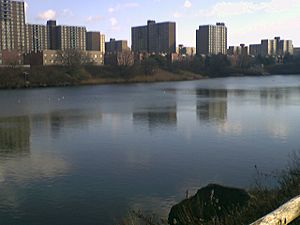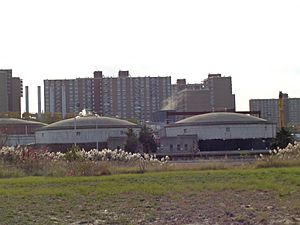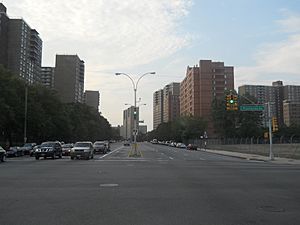Starrett City, Brooklyn facts for kids
Quick facts for kids
Starrett City
Spring Creek Towers |
|
|---|---|
|
Neighborhood of Brooklyn
|
|

Starrett City, seen across Fresh Creek Basin
|
|
| Country | |
| State | |
| City | |
| Borough | |
| Community District | Brooklyn 5 |
| Opened | 1974 |
| Founded by | United Housing Foundation, Starrett City Associates |
| Time zone | UTC−5 (Eastern) |
| • Summer (DST) | UTC−4 (EDT) |
| ZIP Codes |
11239
|
| Area code(s) | 718, 347, 929, and 917 |
Starrett City, also known as Spring Creek Towers, is a very large housing community in Brooklyn, New York City. It is located in the Spring Creek part of East New York. This community sits on a piece of land surrounded by water, with Fresh Creek to the west and Hendrix Creek to the east. Starrett City has many apartment buildings and also places for shops and businesses.
The residential area of Starrett City is divided into eight sections. Each section has several buildings and its own outdoor space for fun. The complex also includes a community center and two schools. Starrett City opened in 1974. It was renamed Spring Creek Towers in 2002, but many people still call it Starrett City.
Starrett City is part of Brooklyn Community District 5. Its main ZIP Code is 11239. The New York City Police Department's 75th Precinct helps keep the area safe.
Contents
Exploring Starrett City's Layout and Features
Starrett City, or Spring Creek Towers, is located on a peninsula. This means it's almost surrounded by water, with Jamaica Bay to the south. It is bordered by Flatlands Avenue to the north and Seaview Avenue to the south. Pennsylvania Avenue runs through the middle of the complex.
How Big is Starrett City?
The development was originally about 153 acres (0.62 km2). After some changes in 2009, it now covers about 140 acres (57 ha). This huge housing area has 5,881 apartment units. These units are spread across 46 buildings, which are 11 to 20 stories tall. Starrett City is known as the largest federally supported rental property in the United States.
Design and Sections of the Community
The famous architect Herman Jessor designed Starrett City. The buildings have a simple, square shape. The residential part of the property has eight different sections. Each section has its own field, a play area with a jungle gym, a park, and courts for handball and basketball. There is also a five-story parking garage for residents in each section.
These sections are named after towns in New York State: Ardsley, Bethel, Croton, Delmar, Elmira, Freeport, Geneva, and Hornell. Besides the homes, Starrett City also has a shopping center.
Starrett City's Own Power and Water Systems
Starrett City has its own power plant, called the Starrett City Cogeneration Facility. It opened in 1973 and provides electricity, heating, cooling, and hot water to all residents. This plant is so good that during the 1977 New York City blackout, the complex was still able to have power.
There is also a sewage treatment plant nearby. It's called the 26th Ward Wastewater Treatment Plant. This plant can clean a lot of water every day from nearby neighborhoods. Since 1982, the power plant and the treatment plant have worked together. The treatment plant gives its methane gas and treated cold water to the power plant. In return, the power plant gives hot water to the treatment plant.
Sports and Recreation Facilities
At the southeast side of the complex, there is a community and recreation center. It opened in 1978 and is now called the Brooklyn Sports Club. It has a pool, tennis courts, an auditorium, and other fun facilities.
Starrett City also has its own boxing gym, called Starrett City Boxing. It opened in 1978 inside a parking garage. Many famous boxers have trained there, including Zab Judah and Shannon Briggs.
Ensuring Safety and Security in Starrett City
Starrett City has its own private security team, called the Spring Creek Towers Department of Public Safety. This team was created because the surrounding area had high crime rates when Starrett City first opened in the 1970s. Because of this security force, Starrett City had very low crime rates in its early years. Some experts even say it's one of the safest communities in the United States.
The Spring Creek Towers Department of Public Safety employs officers who are armed while on duty. They work to keep residents and their property safe. These officers enforce New York state and city laws. They patrol the area 24 hours a day, on foot, bicycles, or in vehicles.
Who Owns and Manages Starrett City?
The complex is owned by Starrett City Associates. This group was originally led by Disque Deane. Former U.S. President Donald Trump owns a small part (4%) of the complex. He inherited this share from his father, Fred Trump.
Learning and Getting Around Starrett City
Starrett City has several schools for younger students. There are no high schools directly inside the complex. However, there are high schools nearby in East New York and Canarsie.
Schools Within the Community
- Abe Stark Elementary School (PS 346)
- Gateway Intermediate School (IS 364)
- Frederick Douglass Academy VIII Middle School (located inside PS 346)
- Be'er Hagolah, a Jewish elementary and high school
The Brooklyn Public Library's Spring Creek Branch is just outside Starrett City's northern border. It is a single-story building that opened in 1977.
Transportation Options for Residents
Starrett City was designed to have good transportation links. It is served by several local and express bus routes operated by MTA Regional Bus Operations. These include the B82, B83, the B82 Select Bus Service, and the BM2, BM5 express buses. Other buses like the B6, B60, and B103 stop nearby.
The closest New York City Subway stations are East 105th Street and Canarsie-Rockaway Parkway. Both are served by the L train train.
The History of Starrett City's Development
The idea for a large housing project on this land goes back to 1962. An investment group bought the land to build a community called Park Shore Village.
Early Plans and Changes
In 1964, plans for Park Shore Village were announced. It would have 19 buildings and include a shopping center, community center, pools, and a new elementary school. This project was approved, but the original investors pulled out due to money problems.
In 1967, a new plan was announced by the United Housing Foundation (UHF). This project was called Twin Pines Village. It was meant to be a cooperative community for 6,000 families. It would have 43 buildings, a shopping complex, and schools. Twin Pines was planned to be the second-largest co-op in New York City. However, the UHF also ran out of money and left the project in 1971.
Starrett City Takes Shape
After the UHF left, a new group of investors, including Disque Deane and Lazard Frères, took over. This group became Starrett City Associates. The project was renamed Starrett City. It was changed from a co-op to rental apartments to make it more profitable.
Construction started again in mid-1972. The builders focused on the southern part first to attract tenants. In 1973, Fred Trump, a real estate developer, bought a 20% share in the project. The Starrett Associates invested $22 million, and the rest of the money came from state housing loans.
Opening and First Years
Starrett City officially opened on October 13, 1974. A special minibus service was created to help residents get around the community and to nearby shopping centers. An express bus service to Manhattan was also extended to Starrett City.
By 1976, two thousand families had moved into Starrett City. A swimming and tennis club opened in 1978. Crime rates in the complex were lower than in surrounding areas, thanks to the private security force. However, rents started to increase in the late 1970s.
In 1989, the complex was briefly renamed "Starrett at Spring Creek." On September 25, 2002, it was renamed "Spring Creek Towers" as part of a $70 million plan to renovate the complex. This plan included new parks, elevators, laundry rooms, windows, and lighting.
Attempts to Sell the Property
In 2006, Starrett City Associates announced they wanted to sell the entire property. This worried tenants because they feared a new owner might raise rents. In 2007, David Bistricer's Clipper Equity LLC agreed to buy the complex for $1.3 billion. However, the U.S. Department of Housing and Urban Development (HUD) rejected the deal twice. They were concerned that the plan did not protect residents enough from rent increases.
In 2008, an agreement was made with government officials to ensure the property would remain affordable if sold. In 2017, The New York Times reported that the complex was being sold for $850 million to the Brooksville Company and Rockpoint Group. Donald Trump and his family owned part of the complex. After some legal disagreements, the sale was completed on May 8, 2018, for $905 million.
Community and Demographics of Starrett City
Starrett City is known for being a very diverse neighborhood.
Population and Diversity
Based on the 2010 United States Census, Starrett City had a population of 13,354 people. The neighborhood covers about 291 acres (1.18 km2).
The racial makeup of the neighborhood in 2010 was:
- 24.7% White
- 52.7% African American
- 0.2% Native American
- 2.9% Asian
- 0% Pacific Islander
- 0.3% from other races
- 1.4% from two or more races
Additionally, 17.9% of the population identified as Hispanic or Latino of any race.



